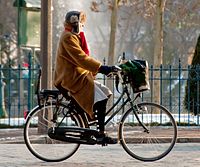
Photo from wikipedia
Abstract Interest into active modes (i.e. walking and cycling) has increased significantly over the past decades, with governments worldwide ultimately aiming for a modal shift towards active modes. To devise… Click to show full abstract
Abstract Interest into active modes (i.e. walking and cycling) has increased significantly over the past decades, with governments worldwide ultimately aiming for a modal shift towards active modes. To devise policies that promote this goal, understanding the determinants that influence the choice for an active mode is essential. The Netherlands is country with a large and demographically diverse active mode user population, mature and complete active mode infrastructure, and safe environment. Mode choice research from the Netherlands enables a comparison on relevant determinants with countries that have a low active mode share. Furthermore, it can provide quantitative input for policies aiming at an active mode shift. This paper estimates a mode choice model focusing on active modes, while including a more comprehensive set of modes (i.e. walking, cycling, public transport and car). Based on data from the Netherlands Mobility Panel (MPN) in combination with an additional survey focused on active modes (coined PAW-AM), this study estimates which determinants influence mode choice. The determinants can be categorized as individual characteristics, household characteristics, season and weather characteristics, trip characteristics, built environment, and work conditions. The results show that all categories of determinants influence both walking and cycling. However, the choice for cycling or walking is affected by different determinants and to a different extent. In addition, no active mode nest was found in the model estimation. Cycling and walking should thus be regarded as two distinguished alternatives. Furthermore, the results show that active mode use is most sensitive to changes in the trip characteristics and the built environment.
Journal Title: Transportation Research Part A: Policy and Practice
Year Published: 2019
Link to full text (if available)
Share on Social Media: Sign Up to like & get
recommendations!